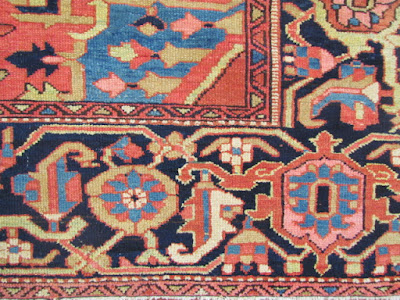With this blog we continue our look at some of the more rare rugs that we have in stock. Last time around it was a classic Bidjar. Today it is an old Heriz.
The typical Heriz design with bold geometric lines and elaborate medallions is one of the most distinctive and recognisable in the world of antique persian rugs. However, the term tern 'Heriz' is bandied about a bit more often than it should be, regularly confused with 'Serapi' rugs, which are effectively very old Heriz rugs.
So let's take a look at one - not the oldest one or the finest one in the store, but a very good representative model for out purposes, exhibiting all of the classic design features of an Antique Heriz, geometric lines, elaborate medallion, good use of vegetable dyes, prominant use of yellow (rare).
In order to better understand the background to this classic Persian rug we should take a glance at geography and the role that history has played in the district of Heriz, for, as across Persia, history goes back a long way and provides many of the answers we search for.
Heriz is a village set in the eastern part of Azerbaijan Province in Iran. This is the more north-westerly part of Persia, and, as the name implies, has a significant Azeri and Turkish element. The most influential city in the region is Tabriz, some fifty miles to the west of Heriz. Tabriz has a long and storied history and came to prominance under the Mongols during the 13th century. The Mongol Ghazan Khan converted to Islam, establishing the Islamic Mongol Il-Khanid Dynasty, the capital of which was made at Tabriz.
The important outcome of this development was that Turkish hordes arrived and settled in the area. Today, the region is wholly Turkish and the language spoken is Turkic. So culturally and linguistically Azerbaijan Province is extremely different from the rest of the country and is viewed with a degree of distrust and misgiving by the Persian majority.
The significance for rug-making is clear. Because the people that inhabit the region are Turks they use the Turkish knot when weaving, as opposed to the more commonly employed Persian knot. A glance at the map below illustrates how difficult it can be to pin the origins of various rugs down, with various groups, mostly those with a stronger nomadic culture, using the Turkish knot, and more settled groups emplying the Persian knot.
 |
| Turkish Knot |
 |
| Persian Knot |
A lot of this can be attributed to the close proximity of Tabriz, which by 1800 AD had a long, esteemed history as a major trade center between east and west. Nearly all Persian production passed north-west, through Tabriz, and then onto Turkey, Russia and Europe.
Heriz is the central village in the region between Tabriz and the Savalan Massif. Heriz is head of a dozen or so villages that make the same type of carpet, using the Turkish knot and double weft. The best carpets are made in Heriz itself. Bakshaish rugs, another common name, are from one of these lesser villages, although the Bakshaish holds the reputation for having the longest production history, although not the finest product.
Also of note here, but to be discussed some other time, are two other significant groups. The first lies between Heriz and Tabriz and is the Karajeh district. Karajeh rugs are very well known and all employ the same highly distinctive motifs. These rugs are single wefted but closely woven. The other major area lies to the south-east from Heriz on the road from Tabriz to Ardebil, and is the town of Sarab, which also makes highly distinctive designs. So a LOT has taken place in this really rather small region, when it comes to Persian rugs.
 |
| Map showing the Heriz district |
 |
| Tabriz on left. Heriz on right |







Nice Information! I personally really appreciate your article. This is a great website. I will make sure that I stop back again!. oriental rugs for sale
ReplyDeleteI have seen your post for carpets and as i am able to see in your post there is good pictures of carpets which is good to know about it keep doing well....designer benches and ottomans
ReplyDeleteGreat Blog with excellent idea! Thank you for such a valuable Blog.
ReplyDeleteTraditional Rug | Traditional Rug Melbourne
Geography and history clearly shaped the character of the Heriz rugs. I like how a small area could produce such distinct designs that still travel across the world. Has anyone experimented with combining antique Persian rugs with modern grey carpets to make a room feel both warm and elegant?
ReplyDelete